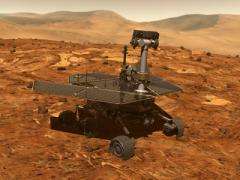Not space junk yet: Mars rovers carry on despite age, ailments

In one of the most remarkable engineering feats of our time, the aging Mars rovers Spirit and Opportunity are still taking orders and sending home pictures more than five years after they were supposed to turn into slabs of space junk.
Opportunity is still rolling along, but Spirit is hung up on a rock and may be reaching the end of its travels. The rovers' masters at NASA's Jet Propulsion Laboratory in Pasadena, Calif., hope they can nurse either or both of them through another harsh Martian winter.
"I'm very attached to them," said John Callas, the rover project manager. "They exhibit humanlike qualities. They have trials and tribulations. Like aging humans, they've got arthritic joints, they forget things, their vision is not what it used to be. When something's not right, you get that sinking feeling in your stomach."
Resembling golf carts loaded with cameras and scientific instruments instead of drivers and putters, the six-wheeled robotic geologists have delivered a cornucopia of information.
They've given scientists a sweeping view of the history of Mars -- once warm and wet, now dry and dusty. They've provided many details about the planet's chemistry, geology and atmosphere. They've proved that water once flowed on its surface.
However, they haven't been able to answer the most important question: Did life ever exist there, or do living organisms perhaps still hide in the planet's crust? There have been hints -- both pro and con -- but nothing definite.
Nevertheless, after sending home more than a quarter-million images, the rovers "have made Mars a familiar place," Callas said. "They've made Mars seem like our own neighborhood. It's no longer a foreign or alien or distant world."
"The rovers are our children," wrote Ashley Stroupe, a member of JPL's rover team, on her blog. "Like parents of adult children who have moved away, we worry, we try to keep them safe, we try to teach them what we know, and we give them guidance. Sometimes they listen, and sometimes they don't. But together, we've made amazing discoveries."
The 5.2-by-7.5-foot rovers landed three weeks apart in January 2004, on opposite sides of Mars. They were supposed to survive for 90 days, but they've been at work for almost 2,000 days, even though their warranty expired long ago.
There have been high points, such as detecting the first definite evidence of liquid water, and low points, as when an enormous dust storm blotted out the sun for six weeks in the summer of 2007, coating the robots' solar panels and reducing their power supply.
"It was touch and go every day," Callas said. "We never knew when we came in every day if the rovers would still be there."
Until recently, the rovers have managed to recover from each setback. Now, Spirit is in deep trouble and may not make it much longer.
The rover lost the use of its right front wheel in 2006, so it's had to drive backward, dragging the useless wheel behind it. It can no longer climb steep slopes. It suffers from periodic bouts of amnesia, forgetting data it's collected. Some mornings it fails to wake up to communicate with its masters on Earth.
Worst of all, since May 7 it's been stuck with a rock under its belly and its wheels half-buried in loose soil the consistency of flour, unable to move. NASA engineers are trying to simulate the problem with a rover model in a "sandbox" at the laboratory, but it will be several weeks before they know if it will work.
"We want to make sure we don't do something stupid and make things worse," Callas said.
Opportunity has been the luckier of the pair since the very beginning. On its landing, it surprised and delighted its managers by making an "interplanetary hole-in-one," plopping down inside a small, scientifically intriguing crater, which the team dubbed Eagle.
Since then, Opportunity has explored two larger craters, named Endurance and Victoria. Now, despite an arthritic shoulder and a cranky electric motor on its right front wheel, it's headed toward a fourth crater, Endeavour, 20 times larger than Victoria.
Almost 14 miles across and about 250 feet deep, Endeavour apparently was created by an enormous meteorite billions of years ago. Like other craters, its walls are "time tunnels," Callas said. "By going down into the crater, we're going back in time. The older rocks are toward the bottom."
Opportunity left Victoria last August and got its first glimpse of Endeavour's uplifted rim -- still seven miles away -- on March 18. If its aching body holds up, the rover should arrive there in the fall of 2010.
On May 25, Opportunity passed a milestone -- a record 10 miles of travel over the Martian landscape. Because of its problems, Spirit has covered a bit less than five miles.
Every year, NASA reviews the rover program to see if it's worth $20 million to keep it going another year. "So far," Callas said, "the answer is yes."
___
(c) 2009, McClatchy-Tribune Information Services.
Visit the McClatchy Washington Bureau on the World Wide Web at www.mcclatchydc.com





















